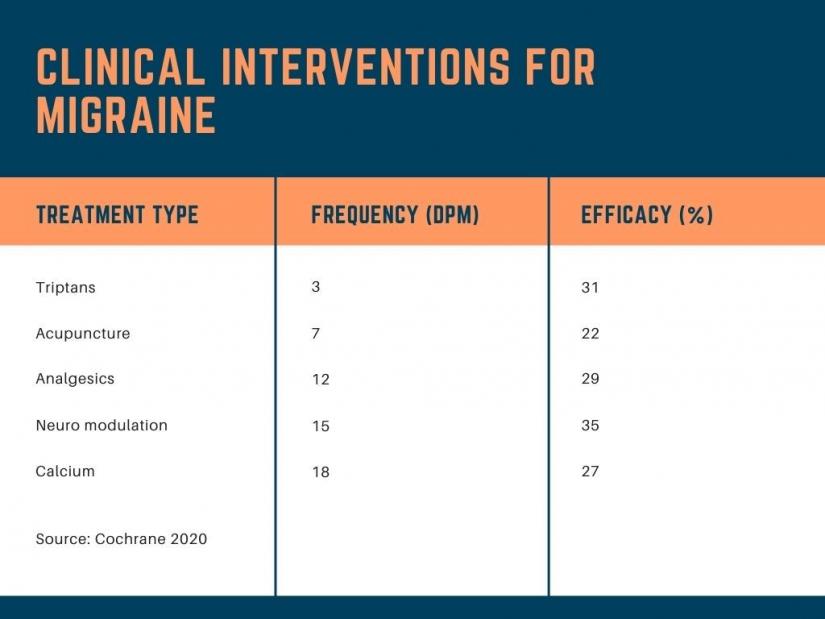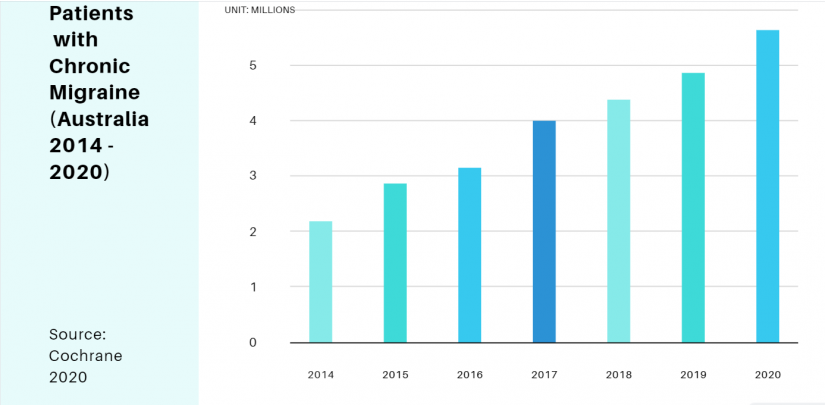What should we include when presenting data?

When reporting on facts, figures and statistics in an academic context you should:
- explain where your information came from;
- focus on the most significant or notable results of your research;
- discuss, interpret and evaluate your findings and why the data is useful.
What does the presentation of data look like in academic writing?
Below is an example of how data can be presented and analysed. Click on each arrow to see more information.
Findings
Table 1 shows clinical intervention ranked according to frequency and effectiveness. The overall results clearly demonstrate that migraine interventions are considered minimally efficacious regardless of the prescribed medication or therapy. Of particular concern, the incidence of clinically reported migraine episodes has been increasing in Australia over the past decade. As shown in Figure 2, the number of people suffering from chronic migraines has more than doubled over the last 7 years. Furthermore, over 80% of migraine sufferers reported that migraines severely affect their quality of life, while nearly three quarters of those surveyed indicated that it negatively impacts their professional duties. Notably, most patients would prefer alternative drug-free interventions, particularly those that experience adverse medical events and long-term side effects. This is particularly evident based on qualitative data whereby many patients describe their experience using medications as “life disrupting”, “untenable” and “unsafe” (Sotir, 2020). These comments provide further evidence that there is no universally acceptable treatment.

|

|
|
Table 1: Treatment Type, Frequency and Efficacy of Migraine Interventions All tables and figures should be numbered and have a concise title which makes clear what information it contains. |
Figure 2: Number of Patients with Chronic Migraine (2014-2020) If a figure is taken from another source, you must cite the source just as you would a quote or paraphrase. Check out the UTS Library referencing guides for more information on how to reference figures and graphs according to different referencing styles. |
Discussion
The results of this research are consistent with previous studies conducted in other countries. In fact, 82% of respondents who stated that migraines severely impact their life is remarkably similar to the results from studies conducted in Japan (Tanaka et al., 2017) and Italy (Perrini, 2015). One area where this research differs, however, is the inclusion of patients aged 18 years and under. It is apparent from the quantitative data in Table 1 and Figure 2, together with the qualitative data compiled, that chronic migraine is a persistent and recurring neurological issue for which no single intervention is superior to the other. However, it is acknowledged that certain treatments may be efficacious for patients on a case-by-case basis. According to estimates from Headache Australia (2019), over 5 million Australians suffer from migraine with an annual economic cost of $45 billion. This is clearly a medical issue that far surpasses any other disease in terms of its impact and thus warrants a concerted effort to reduce the debilitating effects that impinge on patients’ quality of life and the healthcare system.
Presenting data
Ask yourself the following questions whenever you are presenting data in your assignment. Click on each question below for more details.
How do I report the results?
1. Only present the most significant results. You do not need to describe all of your data in the text.
e.g. The overall results clearly demonstrate that migraine interventions are considered minimally efficacious regardless of the prescribed medication or therapy.
2. If necessary, large volumes of data may be included in a separate section entitled “Appendix” at the end of your document, and can be referred to in the text.
e.g. A notable feature of the survey responses was the consistency with which respondents referred to chronic migraines as reducing the quality of their life (see Appendix A for the full list of survey responses).
3. Refer clearly to tables/graphs/charts/images in your text.
e.g. Table 1 shows clinical interventions ranked according to frequency and efficacy, based on quantitative and qualitative data obtained from the systematic review and meta-analyses.
4. Distinguish between qualitative and quantitative data.
- Quantitative data describes quantity, so it expresses number, amount or range.
e.g. In fact, 82% of respondents who stated that migraines severely impact their life is remarkably similar to the results from studies conducted in Japan (Tanaka et al., 2017) and Italy (Perrini, 2015).
- Qualitative data describes how people experience something, so it looks at the quality rather than the amount.
e.g. This is particularly evident based on qualitative data whereby many patients describe their experience using medications as “life disrupting”, “untenable” and “unsafe” (Sotir, 2020).
How do I interpret the results?
1. Discuss the significance of the results based on your interpretation or evaluation.
e.g. This is clearly a medical issue that far surpasses any other disease in terms of its impact and thus warrants a concerted effort to reduce the debilitating effects that impinge on patients’ quality of life and the healthcare system.
2. Integrate findings from various sources to explore the topic in more depth.
e.g. It is apparent from the quantitative data in Table 1 and Figure 2, together with the qualitative data compiled, that chronic migraine is a persistent and recurring neurological issue for which no single intervention is superior to the other.
3. Connect your results to other research.
e.g. The results of this research are consistent with previous studies conducted in other countries. For example…..
What language should I use when describing data?
1. Select the correct verb tense when writing about your data.
| VERB TENSE | EXAMPLE SENTENCE | EXPLANATION |
|---|---|---|
| Present perfect (continuous/progressive) |
Of particular concern, the incidence of clinically reported migraine episodes has been increasing in Australia over the past decade. |
Describes an event or action that started in the past and has been continuing up to now. |
| Present simple |
The results clearly demonstrate that migraine interventions are considered minimally efficacious regardless of the prescribed medication or therapy. |
Describes a fact, or provides an interpretation or opinion. |
| Past Simple |
Furthermore, over 80% of migraine sufferers reported that migraines severely affect their quality of life, while nearly three quarters of those surveyed indicated that it negatively impacts their professional duties. |
Describes an action that took place previously or explains the results of an investigation or analysis. |
2. Use appropriate reporting verbs to indicate where the information came from.
e.g. According to estimates from Headache Australia (2019), over 5 million Australians suffer from migraine with an annual economic cost of $45 billion.
Here is a list of common reporting verbs used in academic writing.
3. Use cautious or tentative language to indicate that other research may provide contradictory findings, or that others may interpret the data differently from your interpretation.
e.g. However, it is acknowledged that certain treatments may be efficacious for patients on a case-by-case basis.
Based on the data presented, it is likely that housing prices will continue to rise for the foreseeable future.
Want to learn more?
- Linked In Learning has a series of videos on reporting data. All UTS students can access LinkedIn Learning free via the UTS Library.
Want some feedback on you report?
CONTACT HELPS

